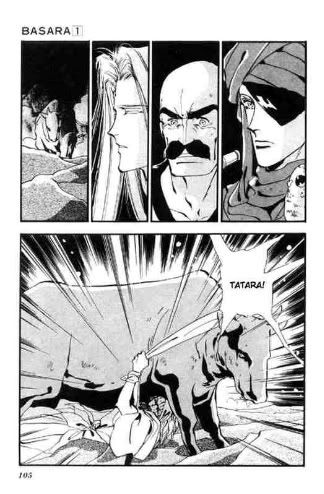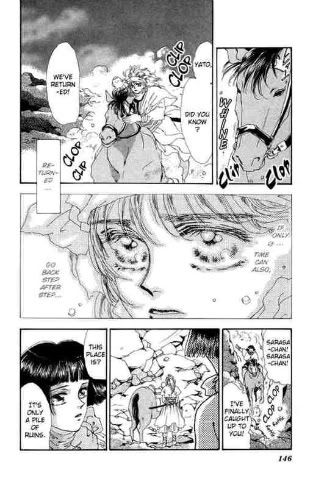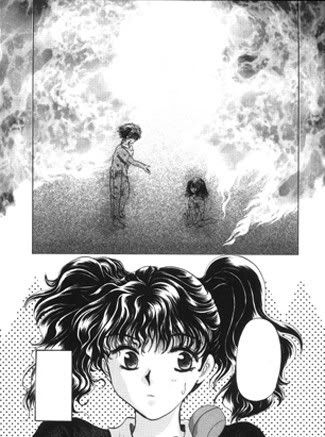Manga Profile: Basara
For my first ever manga profile, it feels only right to begin with Basara, my all time favourite. Especially since it seems to be rather obscure, I hardly ever find volumes of it in any book stores or comic shops and if there do happen to be a few, they are always random ones. Currently I own and have read 22 out of the 27 volumes, and I'm waiting for 23 to come in, but its taking exceptionally long for some reason.
 The first volume's cover, shown on the left is very deceptive. Making the manga look rather boring and action oriented. Yet, the opposite is true, Basara is one of the most entertaining manga I have ever read and although it has action, the primary focus is on the relationships between the characters. This is one gem that should not be over looked.
The first volume's cover, shown on the left is very deceptive. Making the manga look rather boring and action oriented. Yet, the opposite is true, Basara is one of the most entertaining manga I have ever read and although it has action, the primary focus is on the relationships between the characters. This is one gem that should not be over looked.
Basic Information:
Title: Basara
Author: Tamura Yumi
Volumes: 27
Publisher: Shogakukan (Betsucomi)
NA Publisher: Viz
The Story
The tale of Basara takes place after a catastrophe has halted human civilization and sent it back to a time of monarchical kings. Japan itself, is divided into many regions, each governed by a son of the current emperor. They are the red king, blue king, black king, and the white king. Sounds cliche so far, but Basara turns this cliche beginning into something very wonderful. Unlike other post-apocalyptic tales, Basara does not focus on the hopelessness of a broken world, or the stupidity of human beings, who brought about this demise. But rather, it focuses on the efforts of human being to change their miserable surroundings. If anything, Basara is a trip into state building, as the main struggle of the manga is about creating a new Japan.
Yet, the emphasis is never solely on building a new Japan, many other themes and sub-plots are woven together into one experience known as Basara. And the beauty of this work is that no one part over powers the other, every single tale is relevant and important. And every single tale connects at some point to the bigger goal, the creation of a new nation.

From this setting, we are introduced to a set of twins, Sarasa and Tatara who are born under the prophacy of liberation. Everyone assumes that Tatara is the child who will liberate them and Sarasa grows up in his shadow. She resents it at first, but gradually she grows to accept it and directs her efforts at cultivating the barren land. But as in all stories, tragedy strikes and her family along with her brother is killed by the Red King, as rebels who threaten the stability of the current regime. Her village is then set on fire and the villagers are in chaos and despair. It is from this moment that the heroine's journey truly begins. She decides to take her dead brother's place in order to protect her people. We see a beautifully symbolic scene, where she cuts off her hair and says she is now Tatara. If anything, it was this scene that won me over and infatuated me with this manga.
As Tatara, Sarasa seeks, at first, ways to avenge her family and protect her people. She begins her journey, not seeking the greater goal, but seeking to kill the one that tore her life to shreds. And slowly along the way, she comes to the realization that what she has to do is so much more.
One of the primary tasks she must accomplish is to gain allies. So along her journey, we are introduced to many different regions and characters , each with a story of their own. The majority of characters you will meet are given sufficient development, but there are a few that are not.
What starts out as a simple tale of Sarasa and her journey to revenge evolves into something very different. And early on one can see, through the introduction of Shuri, that the road Sarasa travels down is one that is never as it seems.
A truly beautiful tale, written with the uttermost of care. It truly is Tamura-san's master peice.
The Art

As much as I love to rave about Basara, I have to admit, the art is the manga's weak point. The art is not bad, but its not spectacular either. Its average, and it gets its job done. Never the less, the art does improve slowly. So near the end, it is of a better quality.
But, I would like to emphasize that the art is but a small issue and does not distract away from the beauty of the story.
The art may not be as beautiful as the story telling, but it gets the job done well.
The Characters
I could write pages and pages about the characters of Basara. The characters are the life of this manga and they are both interesting and human. Almost all the characters get a good background story and their actions are justified. They do not do things for the sake of being evil or just wanting power. They have a reason behind all their actions. As I will go into the characters eventually on their own I won't focus too much on them here. But I will just give a few examples and these contain spoilers!!!!
(1)SARASA- the heroine of our tale, she is strong willed with a deep loyalty to her comrades. Nevertheless, Sarasa is easily put into doubt. Early on in her journey, after her rash actions cause the deaths of her grandfather and friend, she is unable to go on as a leader and sinks into a state of depression. This happens again after she realizes who the Red King really is, but this depression and psychological trauma is explored in much more detail than in the other instances. Sarasa also grows from an individual fueled by revenge, to an individual who seeks to build a country where there is no violence and oppression. She has weaknesses, like all human beings, but the strength of her character is derived from the fact that she faces these weaknesses and becomes a better and stronger person as a result.
(2)SHURI- the hero and antagonist, shuri is really an interesting character to watch develop. He is rather twisted and has an interesting, to say the least, view of the world. Much of his actions are the result of his childhood, where he was branded a slave because it was foretold he would bring his father ruin. His father kept him alive as the shark that would keep his other sons in line, hence he is given the title of Red King. Shuri is very arrogant, but we slowly see him change for the better, not just because of Sarasa, but also because he looses everything that had once been his as the Red King.
(3)ASAGI- Just as interesting as shuri, asagi is the real blue king and he joins Tatara's rebel army for reasons unknown. He remains a mystery in the early volumes of the manga, but slowly his story is revealed and does it sure explain a lot. Let's just say he has a inferiority complex ;)
(4)SENJU- a far less developed side character, nevertheless, she does get some development and even shows a strength of her own. Her tragedy makes Sarasa realize that the soldiers in the red army are not demons, but men with families of their own. I grow to like Senju because of the decision she makes with regards to her child.
& there are so much many more characters, Basara has a large cast!
Themes
***I am using the term 'theme' in a very loose sense, meaning it can be anything from something the story focuses on, to an aspect of the story, or the actual meaning of the word in its literary sense. Nor am I going to go into too much detail, this blog entry is already really long ;) ***
1. Political Change
Basara's central theme is political change, why it is undertaken and how it can be undertaken. Basara portrays a very romantic image of political change, where a group of oppressed people band together as rebels to overthrow the corrupt regime and institute a regime of freedom (or as it is popularly known, democracy). This does not mean that everything is rosy, but rather that Basara never explores the other side of the story, where rebellions do more harm then good. So that in Basara, rebellions are portrayed as something good stemming from the people's accurate assessment of the situation and their commitment to a truly free regime. I myself, in fact, am very fond of this portrayal and fully enjoy this aspect of Basara.
The method of change is very romantic in Basara too, it is the stuff which legends are made of, which, I find, is not a bad thing. There are four swords and four rebellion leaders, each from different areas of Japan. So that when the four swords are united, so are the people of Japan. It really fits the feel of Basara and I find I really like the concept.
2. Gender
Not as prominent as political change, but it is present nonetheless. The first volumes set the premise, and the subsequent volumes slowly undermine it. Basically, in the world of basara, like our own, gender determines what you can do and cannot do. Because Sarasa is female, no one ever thinks that it is in fact she who will liberate Japan and not her brother. There are quite a few scenes in the frist volume where gender discrimination is shown in all its glory. We are shown that men are the leaders and warriors. And then we are shown Sarasa taking on the task of leader and warrior. All subsequent volumes, through the story itself, work to disprove that only men can be leaders and warriors. Through Sarasa's success, the gender specific roles are demolished. Likewise at the beginning, Sarasa becomes Tatara, she rejects her femininity and dons on a male appearance. But subsequent volumes slowly undermine this; they not only blur the distinction between male Tatara and female Sarasa, but we also see Sarasa regaining her image as female. Especially in later volumes, where she reveals her identity to her comrades and accepts Shuri as the Red King, Sarasa makes the final leap in bridging the gap between what is male and what is female; she accepts both aspects as herself.
There are other points in the story that touch on this too, Chacha like Sarasa, is a successful warrior and leader. Ginko, the white king, is tried of her life being set up for her and seeks to destroy the very society and political structure that has forced her to live a life that is not hers. These subtle instances all work together to discredit the stereotypical view of gendered roles and of submissive females. I see no submissive females in Basara. Even the very feminine Senju, is portrayed as active, not passive; she actively seeks Shido's love, rather then passively wait for it. She actively seeks the aid of others in order to protect her child, rather then passively waith and hope for the best. Yes, Basara is one of those rare shoujo titles that disregards the accepted steritypical view of what is female and makes an attempt to redefine femininity in an image that is more proactive and strong.
3. Good vs. Evil
Being the epic it is, Basara includes the theme of good versus evil. Yet, it's presented in an unconventional way, almost abolishing the distinction all together. It would not be incorrect to say that rather then good versus evil, we have good methods versus twisted evil methods. The protagonist seeks the proper method, often herself stumbling onto methods that are not so good. The antagonists use evil methods, but for good reasons, and often they are either aware of this or they become aware and correct themselves.
Sarasa and Shuri both seek to rebuild Japan, but Sarasa because of who she is, will not use methods that result in evils being done to her allies. Nevertheless, there are instances where she makes mistakes and causes pain and death upon others. Two examples of this include her rash desire to kill the Red King resulting in two deaths, and her plan to defeat the Red King by cutting off his city's water supply resulting in the justified anger of the people of Suo. Both her methods are done for something that is good; the liberation of Japan, but the methods themselves cause death and suffering. Likewise, Shuri is determined to change Japan for the better, his city is living proof of that, but the method he uses in order to produce change leaves a trail of blood.
There are many other misguided villains (if we can call them that), including the guardsmen of Abashiri Prison, Momonoi, the temporary ruler of Suo, and Ginko, the white king. The only villains, in the real sense of the word, appear to be Emperor Ukon and Higiwara. As of yet (volume 22), we are not given much information about Ukon, and while Higiwara has his reasons, they are selfish ones.
In Basara, the ends do not justify the means
Conclusion
Basara is my all time favourite manga, and I really feel it deserves to be recognized. It has a beautifully powerful story with interesting characters that anyone can relate to and art that conveys what is required. If you read manga for art only or don't like shoujo, then Basara is probably not for you. But to everyone else, I recommend you at least try Basara out, you may be as pleasantly surprised as I was the first time I gave it a try.
Because this is my first manga profile, it will probably undergo some changes until i standardize the sub sections and the like. I'm still not sure how long I want the character and theme sections to be. I plan on doing character profiles and I may start theme discussions on manga too. Other then that, I am quite satisfied with the outcome, and to whomever is reading, I hope you enjoyed my long rant, and do I just love to rant. If you have a suggestion, feel free to comment :)
~~Joanna.



















